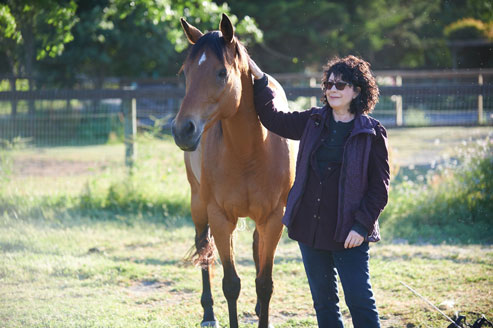The Art of Allowing in Business Relationships
By Razelle Janice Drescher
Allowing vs. Controlling in Business Relationships
“Authenticity builds trust in relationships.”
Lisa Walters, “IN THE FIELD with Horses”
“Allowing vs. Controlling” is an approach to leadership that cultivates authentic workplace relationships and maximizes the potential for effective collaboration and creative problem solving in all business relationships. Trying to control outcomes in a business results in limitations that stifle creative input and collaboration.
Allowing springs from having clarity about what you want along with the ability to invite ideas that match what you want. It involves a shift in focus from efforting to “make” something happen to “allowing” your vision to unfold with ease. A culture of allowing invites authentic engagement from all parties based on trust. Trust thrives in an environment of self-alignment and congruent communication.
True leaders express passion and authenticity that is magnetic. The leader’s ability to step back and allow ideas from others who share their vision is the recipe for an environment of allowing. This requires both self-trust and trust of others. Self-trust is a vital because the leader has to trust her ability to guide the company toward the fulfillment of the vision as she allows ideas from others that may create new possibilities. Trusting others is essential as it opens the door to ideas that may enhance the leader’s vision.
The shift from controlling to allowing begins with an individual’s willingness to focus their attention on what they want instead of what they don’t want. This often means creating a new habit since many people tend to keep thinking about what they don’t want. To accomplish this shift in thinking, it helps to first notice your thoughts. If you find they are focused on the negative, simply replace them with better thoughts that express what you do want. The next step is to allow thoughts that match what you want. These thoughts and ideas can come from yourself or others.
What makes this work is the strength of your alignment with what you want. There has to be congruence between your core intentions and the thoughts you are thinking. It there is a lack of congruence, it will create a disconnect between what you say you want and what you really want. If what you say you want matches your core intentions the effect will be magnetic and will attract ideas that match.
You can strengthen the effectiveness of allowing with increased presence and awareness. Through activities like breathing exercises and meditation, your core intentions become more accessible, and you begin to notice how to stay more attuned to your true intentions. Business owners have the opportunity to cultivate an environment of allowing in their business by staying true to their intentions, connecting to their passion and inviting their employees to do the same.
The business owner’s passion about her business vision becomes the magnet that draws others who are inspired by the business vision and want to be part of it. For managers, allowing is an inclusive management style that lays the ground for inviting the best from employees. For employees, it opens the door to authentic engagement resulting in contributions that enhance their sense of both personal and business value. A culture of allowing has a positive impact on these work relationships as well as the customer experience and other business relationships by opening up possibilities that result from the increased presence and awareness coupled with clarity of intention.
There are 3 essentials for establishing a culture of allowing based on authentic engagement and trust.
- Create shared expectations.
Hiring the right people, the ones who share the passion you have for your business vision, is the first step toward establishing an environment of allowing. By communicating the passion you have for your business vision, you give potential hires a chance to understand the opportunity and determine if it is a good fit.
- Cultivate enhanced presence and awareness.
Enhanced presence and awareness support your employees’ ability to authentically engage in workplace collaboration and creative problem solving. Provide opportunities for your employees to engage in activities that support an atmosphere of allowing such as meditation, yoga and breathing exercises.
- Offer opportunities for input from others.
Activities like brainstorming, strategy sessions and conversations with the employee’s manager are some of the ways to offer opportunities to receive creative and collaborative input. Authentic engagement founded in trust with people who are aligned with your business vision has the potential to produce unexpected outcomes that enhance business operations and move the business forward.
Leading through allowing opens up the space for the valuable contributions from others who share your vision. This leadership model is the fuel that ignites the potential in everyone in an organization. It’s all about cultivating presence and awareness that opens the door to authentic engagement in an atmosphere of ease and possibility. As trust grows, tension and stress are replaced with a sense of calm and well-being that is contagious. Controlling has limits. Allowing opens the door to opportunity. A leadership style of allowing benefits all stakeholders.
